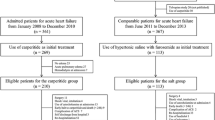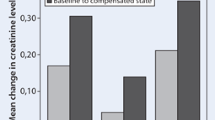Abstract
Background
In advanced congestive heart failure (CHF), intravenous (i.v.) inotropic agents, i.v. diuretics, ultrafiltration, and hemodialysis have been shown to not yield better clinical outcomes. In this scenario, the simultaneous administration of hypertonic saline solution (HSS) and furosemide may offer a more effective therapeutic option with a good safety profile.
Methods
Therefore, a meta-analysis was performed to compare combined therapy, consisting of i.v. furosemide plus concomitant administration of HSS, with i.v. furosemide alone for acute decompensated heart failure (ADHF). The outcomes we chose were all-cause mortality, risk of re-hospitalization for ADHF, length of hospital stay, weight loss, and variation of serum creatinine.
Results
Based on five randomized controlled trials (RCTs) involving 1,032 patients treated with i.v. HSS plus furosemide vs. 1,032 patients treated with i.v. furosemide alone, a decrease in all-cause mortality in patients treated with HSS plus furosemide was proven [RR = 0.57; 95 % confidence interval (CI) = 0.44–0.74, p = 0.0003]. Likewise, combined therapy with HSS plus furosemide was shown to be associated with a reduced risk of ADHF-related re-hospitalization (RR = 0.51; 95 % CI = 0.35–0.75, p = 0.001). Besides, combined therapy with HSS plus furosemide was found to be associated with a reduced length of hospital stay (p = 0.0002), greater weight loss (p < 0.00001), and better preservation of renal function (p < 0.00001).
Conclusion
HSS as an adjunct to i.v. furosemide for diuretic-resistant CHF patients led to a better renal safety profile and improved clinical endpoints such as mortality and heart failure-related hospitalizations.
Zusammenfassung
Hintergrund
Bei fortgeschrittener kongestiver Herzinsuffizienz (CHF) haben intravenös (i.v.) applizierte inotrope Substanzen, i.v.-Diuretika, Ultrafiltration und Hämodialyse nachgewiesenermaßen nicht zu besseren klinischen Ergebnissen geführt. Im vorliegenden Szenario stellen die gleichzeitige Gabe von hypertoner Kochsalzlösung (HSS) und Furosemid möglicherweise eine wirksamere therapeutische Option mit gutem Sicherheitsprofil dar.
Methoden
Daher wurde eine Metaanalyse durchgeführt mit dem Ziel, die kombinierte Therapie aus Furosemid i.v. plus begleitender Gabe von HSS mit der Gabe von Furosemid i.v. allein bei akut dekompensierter Herzinsuffizienz (ADHF) zu vergleichen. Die gewählten Endpunkte waren Mortalität aus sämtlichen Ursachen, Risiko der Wiederaufnahme ins Krankenhaus wegen ADHF, Krankenhausverweildauer, Gewichtsabnahme und Veränderung des Serumkreatinins.
Ergebnisse
Auf der Grundlage von 5 randomisierten kontrollierten Studien mit 1032 Patienten, die mit HSS plus Furosemid i.v. behandelt wurden, versus 1032 Patienten, die mit Furosemid i.v. allein behandelt wurden, wurde eine Abnahme der Mortalität aus sämtlichen Ursachen bei Patienten mit der Gabe von HSS plus Furosemid nachgewiesen (RR = 0,57; 95%-Konfidenzintervall, 95%-KI: 0,44–0,74; p = 0,0003). Gleichermaßen wurde gezeigt, dass die kombinierte Therapie aus HSS plus Furosemid mit einem verminderten Risiko einer stationären Wiederaufnahme wegen ADHF einherging (RR = 0,51; 95%-KI: 0,35–0,75; p = 0,001). Außerdem stellte sich heraus, dass die kombinierte Therapie aus HSS plus Furosemid mit einer geringeren Krankenhausverweildauer (p = 0,0002), größerer Gewichtsabnahme (p < 0,00001) und besserer Aufrechterhaltung der Nierenfunktion (p < 0,00001) assoziiert war.
Schlussfolgerung
Mit HSS zusätzlich zu Furosemid bei diuretikaresistenten CHF-Patienten wurde eine Verbesserung des renalen Sicherheitsprofils und klinischer Endpunkte wie Mortalität und herzinsuffizienzbedingte stationäre Aufnahme wahrscheinlich.








Similar content being viewed by others
References
Liszkowski M, Nohria A (2010) Rubbing salt into wounds: hypertonic saline to assist with volume removal in heart failure. Curr Heart Fail Rep 7(3):134–139
Paterna S, Di Pasquale P, Parrinello G et al (2000) Effects of high-dose furosemide and small-volume hypertonic saline solution infusion in comparison with a high dose of furosemide as a bolus, in refractory congestive heart failure. Eur J Heart Fail 2(3):305–313
Issa VS, Bacal F, Mangini S et al (2007) Hypertonic saline solution for renal failure prevention in patients with decompensated heart failure. Arq Bras Cardiol 89(4):251–255 (Article in English, Portuguese)
Licata G, Di Pasquale P, Parrinello G et al (2003) Effects of high-dose furosemide and small-volume hypertonic saline solution infusion in comparison with a high dose of furosemide as bolus in refractory congestive heart failure: long-term effects. Am Heart J 145(3):459–466
De Vecchis R, Ciccarelli A, Ariano C et al (2011) Renoprotective effect of small volumes of hypertonic saline solution in chronic heart failure patients with marked fluid retention: results of a case-control study. Herz 36(1):12–17
Butler J, Forman DE, Abraham WT et al (2004) Relationship between heart failure treatment and development of worsening renal function among hospitalized patients. Am Heart J 147(2):331–338
Cioffi G, Tarantini L, Pulignano G et al (2007) Prevalence, predictors and prognostic value of acute impairment in renal function during intensive unloading therapy in a community population hospitalized for decompensated heart failure. J Cardiovasc Med (Hagerstown) 8(6):419–427
Brandimarte F, Mureddu GF, Boccanelli A et al (2010) Diuretic therapy in heart failure: current controversies and new approaches for fluid removal. J Cardiovasc Med (Hagerstown) 11(8):563–570
De Vecchis R, Ciccarelli A, Pucciarelli A (2010) Unloading therapy by intravenous diuretic in chronic heart failure: a double-edged weapon? J Cardiovasc Med (Hagerstown) 11(8):571–574
Wittner M, Di Stefano A, Wangemann P, Greger R (1991) How do loop diuretics act? Drugs 41(Suppl 3):1–13
Penfield WG (1919) The treatment of severe and progressive hemorrhage by intravenous injections. Am J Physiol 48:121–128
Crystal GJ, Gurevicius J, Kim SJ et al (1994) Effects of hypertonic saline solutions in the coronary circulation. Circ Shock 42:27–38
Maningas P (1987) Resuscitation with 7.5 % NaCl in 6 % dextran-70 during hemorrhagic shock in swine: effects on organ blood flow. Crit Care Med 15:1121–1126
Rocha-e-Silva M, Negraes GA, Soares AM et al (1986) Hypertonic resuscitation from severe hemorrhagic shock: patterns of regional circulation. Circ Shock 19:165–175
Mazzoni MC, Borgström P, Arfors KE, Intaglietta M (1988) Dynamic fluid redistribution in hyperosmotic resuscitation of hypovolemic hemorrhage. Am J Physiol 255(3 Pt 2):H629–H637
Maningas PA, Mattox KL, Pepe PE et al (1989) Hypertonic saline-dextran solutions for the prehospital management of traumatic hypotension. Am J Surg 157:528–534
Armistead CW, Vincent JL, Preiser JC et al (1989) Hypertonic saline solution-hetastarch for fluid resuscitation in experimental septic shock. Anesth Analg 69:714–720
Ing RD, Nazeeri MN, Zeldes S et al (1994) Hypertonic saline/dextran improves septic myocardial performance. Am Surg 60:507–508
Kien ND, Kramer GC (1989) Cardiac performance following hypertonic saline. Braz J Med Biol Res 22:2245–2248
Kazory A, Ross EA (2008) Contemporary trends in the pharmacological and extracorporeal management of heart failure: a nephrologic perspective. Circulation 117(7):975–983
Detsky AS, Naylor CD, O’Rourke K et al (1992) Incorporating variations in the quality of individual randomized trials into meta-analysis. J Clin Epidemiol 45(3):255–265
Paterna S, Di Pasquale P, Parrinello G et al (2005) Changes in brain natriuretic peptide levels and bioelectrical impedance measurements after treatment with high-dose furosemide and hypertonic saline solution versus high-dose furosemide alone in refractory congestive heart failure: a double-blind study. J Am Coll Cardiol 45(12):1997–2003
Paterna S, Fasullo S, Di Pasquale P (2005) High-dose torasemide is equivalent to high-dose furosemide with hypertonic saline in the treatment of refractory congestive heart failure. Clin Drug Investig 25(3):165–173
Paterna S, Fasullo S, Parrinello G et al (2011) Short-term effects of hypertonic saline solution in acute heart failure and long-term effects of a moderate sodium restriction in patients with compensated heart failure with New York Heart Association class III (Class C) (SMAC-HF Study). Am J Med Sci 342(1):27–37
Issa VS, Andrade L, Ayub-Ferreira SM et al (2013) Hypertonic saline solution for prevention of renal dysfunction in patients with decompensated heart failure. Int J Cardiol 167(1):34–40
Engelmeier RS, Le TT, Kamalay SE et al (2012) Randomized trial of high dose furosemide-hypertonic saline in acute decompensated heart failure with advanced renal disease. JACC 59(13):E958
Parrinello G, Di Pasquale P, Torres D et al (2012) Troponin I release after intravenous treatment with high furosemide doses plus hypertonic saline solution in decompensated heart failure trial (Tra-HSS-Fur). Am Heart J 164(3):351–357
Parrinello G, Paterna S, Di Pasquale P et al (2011) Changes in estimating echocardiography pulmonary capillary wedge pressure after hypersaline plus furosemide pert furosemide alone in decompensated heart failure. J Card Fail 17(4):331–339
Tuttolomondo A, Pinto A, Di Raimondo D et al (2011) Changes in natriuretic peptide and cytokine plasma levels in patients with heart failure, after treatment with high dose of furosemide plus hypertonic saline solution (HSS) and after a saline loading. Nutr Metab Cardiovasc Dis 21(5):372–379
Redfors B, Swärd K, Sellgren J, Ricksten SE (2009) Effects of mannitol alone and mannitol plus furosemide on renal oxygen consumption, blood flow and glomerular filtration after cardiac surgery. Intensive Care Med 35(1):115–122
Filippatos GS, Desai RV, Ahmed MI et al (2011) Hypoalbuminaemia and incident heart failure in older adults. Eur J Heart Fail 13(10):1078–1086
Clarke MM, Dorsch MP, Kim S et al (2013) Baseline albumin is associated with worsening renal function in patients with acute decompensated heart failure receiving continuous infusion loop diuretics. Pharmacotherapy 33(6):583–588
Drazner MH, Palmer BF (2003) Hypertonic saline: a novel therapy for advanced heart failure? Am Heart J 145(3):377–379
Schrier RW (1990) Effects of furosemide treatment in patients with congestive heart failure. In: Lasix 25th Anniversary Symposium. Proceedings of the International Symposium, pp 83–94, Frankfurt am Main 1990. Media Medica, Frankfurt am Main
Tucker BJ, Blantz RC (1984) Effect of furosemide administration on glomerular and tubular dynamics in the rat. Kidney Int 26:112–121
He XR, Greenberg SG, Briggs JP, Schnermann J (1995) Effects of furosemide and verapamil on the NaCl dependency of macula densa-mediated renin secretion. Hypertension 26:137–142
Compliance with ethical guidelines
Conflict of interest. R. De Vecchis, C. Esposito, C. Ariano, and S. Cantatrione declare that there are no conflicts of interest. The accompanying manuscript does not include studies on humans or animals.
Author information
Authors and Affiliations
Corresponding author
Additional information
Additional material onlineThis article includes additional material online. You will find this supplemental at dx.doi.org/10.1007/s00059-013-4041-6.
Electronic supplementary material
Rights and permissions
About this article
Cite this article
De Vecchis, R., Esposito, C., Ariano, C. et al. Hypertonic saline plus i.v. furosemide improve renal safety profile and clinical outcomes in acute decompensated heart failure. Herz 40, 423–435 (2015). https://doi.org/10.1007/s00059-013-4041-6
Received:
Revised:
Accepted:
Published:
Issue Date:
DOI: https://doi.org/10.1007/s00059-013-4041-6




